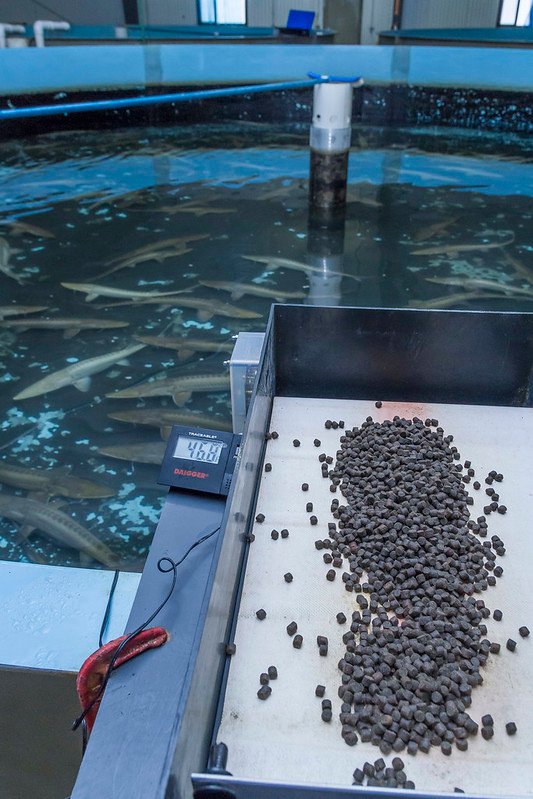For fish farmers, accurately predicting the weight of fish is crucial for optimizing food allocation, managing stock levels, and maximizing profitability. Traditional methods often involve manual weighing, which can be time-consuming and labor-intensive.
Fortunately, the rise of machine learning offers a promising solution: automated prediction of body weight through image analysis.
In this context, a team of scientists from the Agricultural University of Athens and Avramar Aquaculture SA established a body weight prediction model for gilthead seabream (Sparus aurata) weighing between 50 and 1000 g.
The quest for accurate weight estimation
This study aimed to develop a precise body weight (BW) prediction model for gilthead seabream weighing between 50 and 1,000 grams. Researchers collected data from 3,312 individual fish, meticulously measured their weight, and captured digital photographs.
From these images, various body measurements were extracted, including total body length, fork length, standard body length, body height, head length, eye diameter, body area, head area, and eye area.
Identification of key predictors of body weight
Statistical analysis revealed a strong association between body weight and several body measurements, particularly standard body length, body height, body area, and ratios between body area and standard body length and body height. These key predictors were then selected for further analysis using various regression models.
Construction of the predictive model
Researchers compared the performance of simple linear regression, multiple linear regression, and second-order polynomial regression. They analyzed the accuracy of the models across the entire dataset, as well as within three specific weight subgroups (50-100 g, 100-500 g, and 500-1000 g).
“A common feature of all the best BW prediction models obtained in the present study, regardless of the BW range in which they were applied, is the involvement of the fish’s body area (BA) as a significant predictor,” reported the scientists.
Stay Always Informed
Join our communities to instantly receive the most important news, reports, and analysis from the aquaculture industry.
They also emphasized that “fins contribute significantly to the area but little to the BW; they continuously fold and unfold while a fish is swimming, although they can also be damaged. Measuring BA without fins is a more precise variable and explains the improvement in related predictions, while it may fit better into computer vision systems.”
The power of machine learning
Results highlighted the clear advantage of using machine learning over traditional methods. Predicting body weight from the entire dataset was much more accurate than predictions made within individual weight subgroups.
Models with higher coefficient of determination (R2) and lower errors (mean absolute percentage error, MAPE) were the power regression of BW with body area (R2: 99.0%, MAPE: 5.8%) and multiple linear regression of BW with standard body length, body area, and ratios between body area and standard body length and body height (R2: 98.6%, MAPE: 5.1%).
Simplicity and Efficiency
While both models boast impressive accuracy, power regression has a clear advantage in simplicity. By requiring only the measurement of body area, it offers a streamlined approach that minimizes time and effort while maintaining exceptional precision.
Conclusion
The models identified in this study represent a significant step forward in developing an accurate and efficient prediction of gilthead seabream body weight. By using artificial vision and machine learning, fish farmers can now achieve higher precision in their operations, leading to better resource management, sustainability, and profitability.
“In conclusion, the power equation between BW and BA reported in the present study [ln(BW) = −8.846 +1.525 × ln(BA) or BW = exp (−8.846 + 1.525 × BA)] can accurately predict the BW of gilthead seabream in the range of 50 to 1000 g, by measuring a single trait, i.e., the monolateral body area without fins,” the researchers concluded.
This research paves the way for further refinement and optimization of these models, potentially incorporating additional factors such as environmental conditions and types of food. As technology continues to evolve, the future of aquaculture appears increasingly bright, driven by the power of data and intelligent analysis.
The study has been funded by HEAL-Link Greece. The study is part of the project ‘Structured Light-Based fish BiOmass estimator – SaLTBOx,’ which is financed by the European Maritime and Fisheries Fund.
Contact
Nafsika Karakatsouli
Laboratory of Applied Hydrobiology, Department of Animal Science
Agricultural University of Athens
Iera Odos 75, 118 55, Athens, Greece
Email: nafsika@aua.gr
Reference (open access)
Karakatsouli, N., Mavrommati, M., Karellou, E.I. et al. Weight prediction of intensively reared gilthead seabream Sparus aurata from morphometric traits measured in images. Aquacult Int (2023). https://doi.org/10.1007/s10499-023-01343-w
Editor at the digital magazine AquaHoy. He holds a degree in Aquaculture Biology from the National University of Santa (UNS) and a Master’s degree in Science and Innovation Management from the Polytechnic University of Valencia, with postgraduate diplomas in Business Innovation and Innovation Management. He possesses extensive experience in the aquaculture and fisheries sector, having led the Fisheries Innovation Unit of the National Program for Innovation in Fisheries and Aquaculture (PNIPA). He has served as a senior consultant in technology watch, an innovation project formulator and advisor, and a lecturer at UNS. He is a member of the Peruvian College of Biologists and was recognized by the World Aquaculture Society (WAS) in 2016 for his contribution to aquaculture.




